英语教学中的德育渗透案例
- 格式:doc
- 大小:40.00 KB
- 文档页数:5
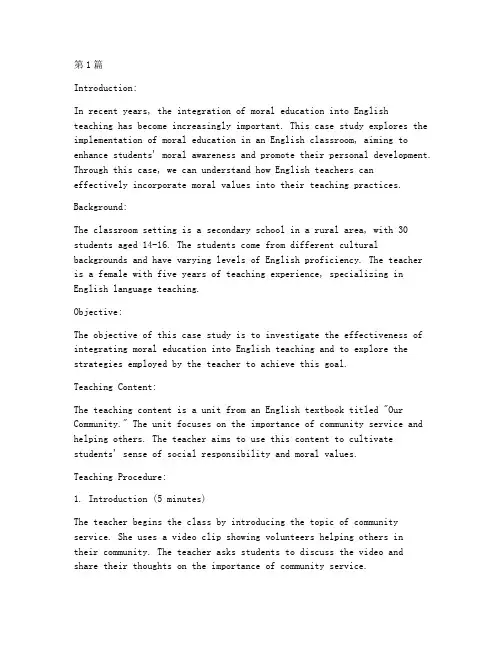
第1篇Introduction:In recent years, the integration of moral education into Englishteaching has become increasingly important. This case study explores the implementation of moral education in an English classroom, aiming to enhance students' moral awareness and promote their personal development. Through this case, we can understand how English teachers caneffectively incorporate moral values into their teaching practices.Background:The classroom setting is a secondary school in a rural area, with 30 students aged 14-16. The students come from different cultural backgrounds and have varying levels of English proficiency. The teacheris a female with five years of teaching experience, specializing in English language teaching.Objective:The objective of this case study is to investigate the effectiveness of integrating moral education into English teaching and to explore the strategies employed by the teacher to achieve this goal.Teaching Content:The teaching content is a unit from an English textbook titled "Our Community." The unit focuses on the importance of community service and helping others. The teacher aims to use this content to cultivate students' sense of social responsibility and moral values.Teaching Procedure:1. Introduction (5 minutes)The teacher begins the class by introducing the topic of community service. She uses a video clip showing volunteers helping others intheir community. The teacher asks students to discuss the video andshare their thoughts on the importance of community service.2. Vocabulary and Grammar (15 minutes)The teacher introduces new vocabulary and grammar points related to community service. She uses examples from the text and encourages students to practice using the new vocabulary and grammar in sentences.3. Reading and Discussion (20 minutes)The teacher assigns a reading passage about a group of students who organized a charity event in their school. Students read the passage individually and then discuss the following questions:- What motivated the students to organize the charity event?- How did the students work together as a team?- What were the challenges they faced and how did they overcome them?- What impact did the charity event have on the community?4. Group Activity (15 minutes)The teacher divides the class into small groups and assigns each group a different community service project. Each group is required to plan and discuss their project, including the purpose, activities, and expected outcomes. The teacher provides guidance and resources to help the students come up with feasible ideas.5. Presentation and Reflection (10 minutes)Each group presents their community service project to the class. After the presentations, the teacher facilitates a class discussion on the importance of community service and how students can contribute to their community.6. Conclusion and Homework (5 minutes)The teacher summarizes the main points of the lesson and emphasizes the importance of moral values and social responsibility. She assigns homework that requires students to write a short essay on how they can contribute to their community in their daily lives.Evaluation:The teacher evaluates the students' performance based on their participation in class discussions, group activities, and the quality of their essays. She also observes the students' behavior and attitudes towards helping others, which is an essential indicator of their moral development.Reflections:1. The integration of moral education into English teaching waseffective in this case. Students were highly engaged in the activities and showed a strong interest in community service.2. The use of multimedia resources, such as videos and reading passages, helped to make the lesson more interactive and engaging for the students.3. Group activities allowed students to work together and develop their teamwork skills, which are crucial for moral development.4. The teacher's guidance and support were essential in helping students come up with feasible community service projects and encouraging them to take action.5. The reflection on personal contributions to the community through the essay assignment allowed students to reflect on their own values and actions.Conclusion:This case study demonstrates the effectiveness of incorporating moral education into English teaching. By integrating moral values into the curriculum and using various teaching strategies, teachers can help students develop a sense of social responsibility and moral awareness.It is crucial for educators to continue exploring and implementing innovative approaches to moral education in order to cultivate well-rounded individuals who can contribute positively to society.第2篇Introduction:Moral education plays a crucial role in shaping the character and values of students. In recent years, the integration of moral education into English teaching has gained increasing attention. This case study aims to explore the effectiveness of moral education in English teaching and provide practical strategies for teachers to implement moral education in their classrooms.Background:The case study was conducted in a middle school in China, where the teacher, Ms. Wang, had been teaching English for five years. Ms. Wang believed that moral education should be an integral part of English teaching, as it helps students develop a positive attitude towards learning and fosters their moral growth.Context:One of the units Ms. Wang taught was about "Respect for Others." The main objective of this unit was to help students understand the importance of respecting others and to encourage them to practice respect in their daily lives. The case study focused on how Ms. Wang integrated moral education into the teaching of this unit.Teaching Methods:1. Incorporating Moral Values into Lesson Plans:Ms. Wang carefully designed the lesson plans to include moral values related to the theme of "Respect for Others." She used a variety of teaching materials, such as texts, videos, and real-life examples, to illustrate the importance of respect.2. Engaging Students in Discussions:To encourage students to think critically about the moral values, Ms. Wang organized class discussions. She asked open-ended questions and encouraged students to share their opinions and experiences. This helped students develop a deeper understanding of the moral values and their relevance in real life.3. Role-Playing and Group Activities:Ms. Wang organized role-playing activities and group projects that allowed students to practice respect in a simulated environment. For example, students were divided into groups and assigned roles such as a teacher, student, and school administrator. They were then asked to resolve conflicts and communicate respectfully with each other.4. Use of Technology:Ms. Wang utilized technology to enhance the moral education component of the lesson. She created a PowerPoint presentation that included videos, pictures, and quotes related to respect. This helped students visualize the moral values and make connections with their own lives.5. Assessment and Feedback:Ms. Wang assessed students' understanding of the moral values through quizzes, essays, and presentations. She provided constructive feedback to help students improve their knowledge and skills in moral education.Results:1. Increased Awareness of Moral Values:Students demonstrated a better understanding of the moral values related to respect. They were more aware of the importance of respecting others and were able to identify situations where respect was necessary.2. Improved Interpersonal Skills:The role-playing and group activities helped students develop better interpersonal skills. They learned to communicate respectfully and resolve conflicts in a constructive manner.3. Positive Attitude Towards Learning:Students showed a more positive attitude towards learning English. They were more motivated to participate in class activities and were willing to take on challenges.4. Transfer of Moral Values to Real Life:Students began to apply the moral values of respect in their daily lives. They showed more consideration for others, and their relationships with classmates and teachers improved.Conclusion:This case study demonstrates the effectiveness of integrating moral education into English teaching. By incorporating moral values into lesson plans, engaging students in discussions, and using various teaching methods, teachers can help students develop a positive attitude towards learning and foster their moral growth. Ms. Wang's approach to moral education in English teaching serves as a valuable example for other educators to follow.。
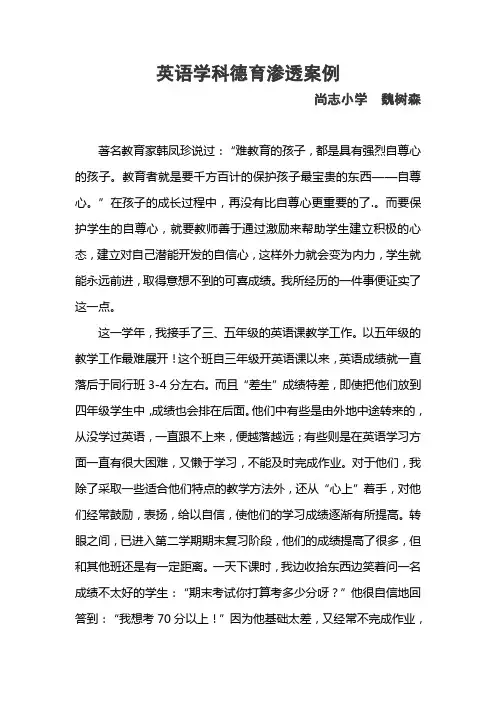
英语学科德育渗透案例尚志小学魏树森著名教育家韩凤珍说过:“难教育的孩子,都是具有强烈自尊心的孩子。
教育者就是要千方百计的保护孩子最宝贵的东西——自尊心。
”在孩子的成长过程中,再没有比自尊心更重要的了.。
而要保护学生的自尊心,就要教师善于通过激励来帮助学生建立积极的心态,建立对自己潜能开发的自信心,这样外力就会变为内力,学生就能永远前进,取得意想不到的可喜成绩。
我所经历的一件事便证实了这一点。
这一学年,我接手了三、五年级的英语课教学工作。
以五年级的教学工作最难展开!这个班自三年级开英语课以来,英语成绩就一直落后于同行班3-4分左右。
而且“差生”成绩特差,即使把他们放到四年级学生中,成绩也会排在后面。
他们中有些是由外地中途转来的,从没学过英语,一直跟不上来,便越落越远;有些则是在英语学习方面一直有很大困难,又懒于学习,不能及时完成作业。
对于他们,我除了采取一些适合他们特点的教学方法外,还从“心上”着手,对他们经常鼓励,表扬,给以自信,使他们的学习成绩逐渐有所提高。
转眼之间,已进入第二学期期末复习阶段,他们的成绩提高了很多,但和其他班还是有一定距离。
一天下课时,我边收拾东西边笑着问一名成绩不太好的学生:“期末考试你打算考多少分呀?”他很自信地回答到:“我想考70分以上!”因为他基础太差,又经常不完成作业,以前也从未考过及格成绩。
而且语文、数学成绩也不看好。
所以看见他有这种想法.便很高兴地点了点头。
刚要说话,只听一名教他的老师笑着插嘴到:“你听他的,他还能考上70多分?能及格就不错了!”另一名老师此时刚好也走进教室。
听了这话,便不假思索的抢白道:“真是的,说的比唱的还好听。
就你这懒样儿,语文、数学都不及格,英语还能及格?你要能及格,谁都能及格了!”话音没落,就见孩子的脸唰的红到了脖子,羞愧的深深地埋下了头……一刹那,我的心灵受到了强烈的震撼,学生那交织着自卑与痛楚的窘迫样儿,至今还一直在我眼前浮现。
使我痛心不已,更为自己曾有过的类似“冒言”而羞愧难当。
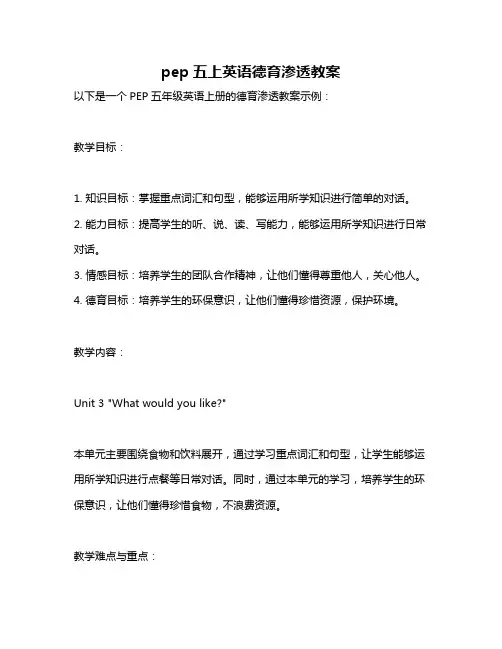
pep五上英语德育渗透教案以下是一个PEP五年级英语上册的德育渗透教案示例:教学目标:1. 知识目标:掌握重点词汇和句型,能够运用所学知识进行简单的对话。
2. 能力目标:提高学生的听、说、读、写能力,能够运用所学知识进行日常对话。
3. 情感目标:培养学生的团队合作精神,让他们懂得尊重他人,关心他人。
4. 德育目标:培养学生的环保意识,让他们懂得珍惜资源,保护环境。
教学内容:Unit 3 "What would you like?"本单元主要围绕食物和饮料展开,通过学习重点词汇和句型,让学生能够运用所学知识进行点餐等日常对话。
同时,通过本单元的学习,培养学生的环保意识,让他们懂得珍惜食物,不浪费资源。
教学难点与重点:难点:如何引导学生正确使用所学句型进行对话。
重点:掌握重点词汇和句型,培养学生的环保意识。
教具和多媒体资源:1. 投影仪2. PPT课件3. 单词卡片4. 食品模型(如汉堡、薯条、饮料等)教学方法:1. 激活学生的前知:通过提问学生平时喜欢吃什么、喝什么,引出本单元的主题。
2. 教学策略:采用实物教学、情境模拟、小组合作等方式,引导学生积极参与课堂活动。
3. 学生活动:小组内进行角色扮演,模拟点餐场景进行对话练习。
教学过程:1. 导入(5分钟)通过提问学生平时喜欢吃什么、喝什么,引出本单元的主题。
教师出示一些食品模型,让学生辨认并说出英文名称。
通过实物教学,激发学生的学习兴趣。
2. 讲授新课(15分钟)教师利用PPT课件展示重点词汇和句型,通过讲解、示范和练习,让学生掌握所学知识。
在教学过程中,教师要注意引导学生运用所学知识进行简单的对话练习,培养他们的听、说能力。
3. 巩固练习(10分钟)学生在小组内进行角色扮演,模拟点餐场景进行对话练习。
通过小组合作,培养学生的团队合作精神。
教师巡回指导,及时纠正学生的发音和语法错误。
同时,教师要注意引导学生运用所学知识解决实际问题,培养他们的环保意识。
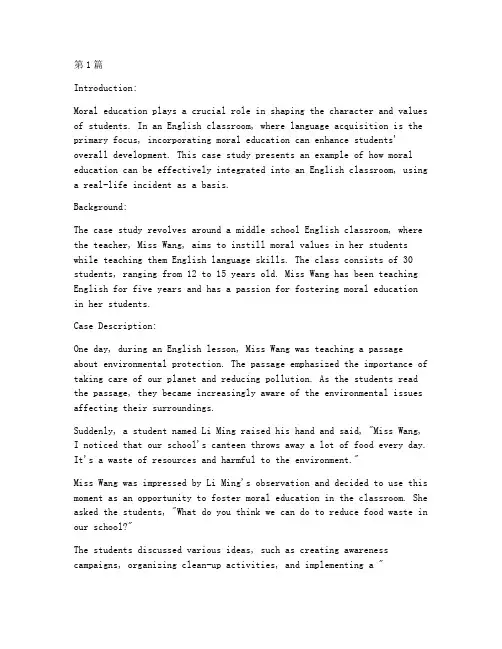
第1篇Introduction:Moral education plays a crucial role in shaping the character and values of students. In an English classroom, where language acquisition is the primary focus, incorporating moral education can enhance students' overall development. This case study presents an example of how moral education can be effectively integrated into an English classroom, using a real-life incident as a basis.Background:The case study revolves around a middle school English classroom, where the teacher, Miss Wang, aims to instill moral values in her students while teaching them English language skills. The class consists of 30 students, ranging from 12 to 15 years old. Miss Wang has been teaching English for five years and has a passion for fostering moral education in her students.Case Description:One day, during an English lesson, Miss Wang was teaching a passage about environmental protection. The passage emphasized the importance of taking care of our planet and reducing pollution. As the students read the passage, they became increasingly aware of the environmental issues affecting their surroundings.Suddenly, a student named Li Ming raised his hand and said, "Miss Wang, I noticed that our school's canteen throws away a lot of food every day. It's a waste of resources and harmful to the environment."Miss Wang was impressed by Li Ming's observation and decided to use this moment as an opportunity to foster moral education in the classroom. She asked the students, "What do you think we can do to reduce food waste in our school?"The students discussed various ideas, such as creating awareness campaigns, organizing clean-up activities, and implementing a "leftovers box" system. Miss Wang then encouraged them to take action by forming a student group dedicated to addressing the issue.Implementation of Moral Education:1. Formation of a Student Group:Miss Wang formed a student group called "Green Team," comprising students who were passionate about environmental protection. The team members were responsible for planning and implementing variousactivities to reduce food waste in the school.2. Awareness Campaign:The Green Team organized an awareness campaign to educate their fellow students about the importance of reducing food waste. They created posters, distributed leaflets, and conducted short presentations during morning assemblies. The campaign aimed to raise awareness and encourage students to be more mindful of their food consumption.3. Clean-Up Activities:The Green Team organized regular clean-up activities in the school premises. They cleaned up littered areas, planted trees, and promoted recycling. These activities not only helped in maintaining a clean and healthy environment but also instilled a sense of responsibility among the students.4. "Leftovers Box" System:The Green Team implemented a "leftovers box" system in the school canteen. Students were encouraged to place their uneaten food in the boxes instead of throwing it away. The leftovers were then used to feed the school's stray animals, reducing food waste and promoting compassion towards animals.5. Collaboration with Teachers and Administrators:The Green Team collaborated with teachers and administrators to ensure the success of their initiatives. They requested the school to providebins for recycling, arranged for regular clean-up activities, and sought support from the school management to implement long-term solutions.Outcome:The efforts of the Green Team and Miss Wang's guidance had a significant impact on the school's environment and the students' moral values. The awareness campaign helped reduce food waste, and the clean-up activities maintained a clean and healthy school environment. The students became more environmentally conscious and developed a sense of responsibility towards their surroundings.Moreover, the moral education aspect of the case study was evident in the students' willingness to take action and contribute to the betterment of their school. They learned the importance of teamwork, empathy, and social responsibility. Miss Wang's approach to integrating moral education into the English classroom not only enhanced their language skills but also shaped their character.Conclusion:This case study highlights the importance of incorporating moral education into an English classroom. By using real-life incidents and fostering student involvement, teachers can create a conducive environment for students to learn and develop morally. Miss Wang's approach to fostering moral education in her English classroom serves as an excellent example of how language acquisition can be combined with character development. Through such initiatives, students can become responsible citizens who contribute positively to society.第2篇Introduction:Moral education is an essential component of a comprehensive education system. It aims to cultivate students' moral values, such as honesty, respect, responsibility, and cooperation. In this case study, we will explore the implementation of moral education in an English classroom, focusing on the teacher's strategies and students' responses.Background:The classroom setting is a secondary school in a rural area. The teacher, Ms. Zhang, is a dedicated and experienced English teacher. The students are from diverse backgrounds and have varying levels of English proficiency.Objective:The objective of this case study is to analyze the effectiveness ofmoral education in the English classroom and identify the teacher's strategies and students' responses.Methodology:The case study follows a qualitative approach, using observations, interviews, and document analysis. Data were collected over a period of one month, including classroom observations, interviews with the teacher and students, and analysis of students' reflective essays.Case Description:1. Introduction of Moral Education:At the beginning of the course, Ms. Zhang introduced the concept ofmoral education in English. She emphasized the importance of moralvalues in daily life and how they can be developed through language learning. The students were encouraged to reflect on their own moral values and relate them to their English learning.2. Incorporating Moral Education into English Lessons:Ms. Zhang integrated moral education into various aspects of her English lessons. Here are some examples:a. Vocabulary Teaching:Ms. Zhang used moral-themed vocabulary to enrich students' language skills. For instance, she introduced words like "honesty," "respect," "cooperation," and "responsibility" and asked students to create sentences using these words. This helped students to understand themeanings and implications of these values in both English and their native language.b. Reading and Discussion:Ms. Zhang selected moral-themed texts for reading assignments. After reading, students engaged in discussions about the characters' actions and their moral implications. This encouraged critical thinking and empathy among students.c. Writing Assignments:Students were asked to write reflective essays on moral issues they encountered in their daily lives. They were encouraged to express their opinions, support their arguments with evidence, and demonstrate their understanding of moral values.3. Students' Responses:The students responded positively to the integration of moral education in the English classroom. Here are some observations:a. Increased Awareness:Students became more aware of their own moral values and the importance of practicing them in their daily lives. They began to pay attention to their behavior and make conscious efforts to be more honest, respectful, and responsible.b. Improved Communication Skills:Through discussions and writing assignments, students developed their communication skills. They learned how to express their opinions, support their arguments, and engage in respectful dialogue with their peers.c. Enhanced Empathy:Students demonstrated increased empathy towards others. They began to understand the perspectives of individuals from diverse backgrounds and showed more compassion towards their classmates.Conclusion:The case study demonstrates the effectiveness of incorporating moral education into the English classroom. By integrating moral-themed vocabulary, reading, discussion, and writing, Ms. Zhang was able to cultivate students' moral values and enhance their language skills. The students' positive responses indicate that moral education can be effectively implemented in language classrooms, contributing to their overall development.Recommendations:1. Teachers should incorporate moral education into various aspects of their language lessons, ensuring that students are exposed to moral values regularly.2. Teachers should encourage students to reflect on their own moral values and relate them to their language learning experience.3. Schools should provide professional development opportunities for teachers to enhance their skills in integrating moral education into language classrooms.4. Continuous assessment and feedback should be provided to monitor the effectiveness of moral education in the English classroom.。
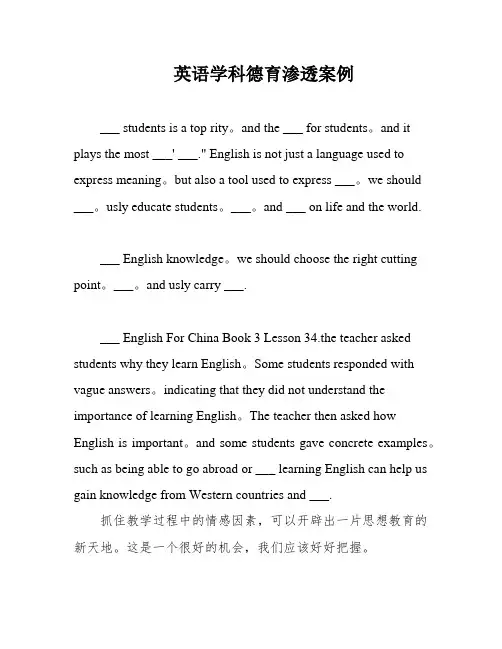
英语学科德育渗透案例___ students is a top rity。
and the ___ for students。
and it plays the most ___' ___." English is not just a language used to express meaning。
but also a tool used to express ___。
we should___。
usly educate students。
___。
and ___ on life and the world.___ English knowledge。
we should choose the right cutting point。
___。
and usly carry ___.___ English For China Book 3 Lesson 34.the teacher asked students why they learn English。
Some students responded with vague answers。
indicating that they did not understand the importance of learning English。
The teacher then asked how English is important。
and some students gave concrete examples。
such as being able to go abroad or ___ learning English can help us gain knowledge from Western countries and ___.抓住教学过程中的情感因素,可以开辟出一片思想教育的新天地。
这是一个很好的机会,我们应该好好把握。
在初中英语教材中,有很多有关日常生活的对话练。

小学英语渗透德育教学案例集团档案编码:[YTTR-YTPT28-YTNTL98-UYTYNN08]小学英语渗透德育教学案例穿芳峪镇果香峪中心小学刘全利小学英语渗透德育教学案例案例背景:很长时间以来,我们的英语教学一直重视学生听、说能力的培养,由于课时紧,内容庞杂等原因,我们的老师很容易忽视德育在英语课堂的渗透。
教育部在新课程设计中,强调了学科之间的整合。
学生学习英语不仅是为了满足人际交往的需要,也是为了用英语获取各方面的信息,学习其他学科的知识。
新教材依据“学会求知”的基本精神,十分重视在学习内容上与其他学科知识的兼容并蓄,精选学生最需要了解的、最感兴趣的、最有普及价值的、与学生日常生活联系最紧密的学科知识内容、容入到语言材料之中,使学生在学习英语的同时,也能够接触到自然科学、社会文化和文学艺术等方面的基础知识,帮助学生了解中西方文化,同时培养学生的爱国主义精神,增强世界意识,为学生的进一步学习奠定良好基础。
本案例正是基于新课改的要求,在一年级英语“Colours"这一课中向学生介绍我们的国旗、国歌,对他们进行爱国主义教育。
培养爱国主义精神。
案例过程:“Colours”这一课的主要目标是学习掌握七个颜色单词:red、yellow、blue、green、orange、purple、pink.在进行完新知识的教授后,学生基本上能够准确地认读这几个单词,并且能反映出单词的中文意思。
然后我设计了一些练习活动,希望通过这些活动帮助学生巩固对这几个颜色单词的掌握,同时也希望通过这些活动能让学生了解到一些课本以外的知识,开阔眼界,使学生能够在丰富多彩、生动有趣的课堂活动中感知语言,学习语言,受到美的熏陶和爱国主义教育。
因为这节课学习的是颜色单词,我家里正好有各个国家的国旗图,这些国旗颜色很鲜艳,很丰富。
我想:如果利用这些国旗设计一些活动,既能巩固学到的颜色单词,又能扩展学生的知识面,帮助学生了解国旗的知识,对学生进行爱国主义教育。

小学英语德育渗透教案【篇一:英语德育渗透教案】英语德育渗透教案it’s important to have a healthy lifestyle第二课时一、教学内容a let’s try and let’s talk二、教学目标(一)、知识目标:1、能够听懂、会说句型:are you helpful at home?what can you do ? i can sweep the floor.you are helpful!并能在情景中运用。
(二)、能力目标:1、能够用what can you do ?询问别人能做什么家务劳动。
2、提高学生的听、说、读、写的能力,特别是读和写的能力得到加强。
(三)、情感目标:使学生养成讲究卫生热爱劳动的好习惯。
三、教学重点、难点1、重点是四会掌握句型:what can you do ? i can…2、难点是句子”are you helpful at home?”以及在实际情景中正确运用所学对话。
四、教学准备1、录音机和录音带。
2、 a部分let’s learn的单词卡片。
五、教学过程step 1 warm uprevisionss:mike,mike , what can you do ?s3: i can …………………………师出示a部分let’s learn的动作词卡,模仿上面的chant和学生一问一答。
t:what what,what can you do?s1:i can sweep the floor.t:what what,what can you do?s2:i can water the flowers.t:what what,what can you do?s3: i can cook the meals.t:what can you do?s4: i can wash the window.t:girls, girls,what can you do?girls, girls :i can clean the bedroom.t:boys,boys, what can you do?boys: i can empty the trash.t:great! you’re helpful.2 学生听录音,跟读let’s learn部分的词汇并拼读。
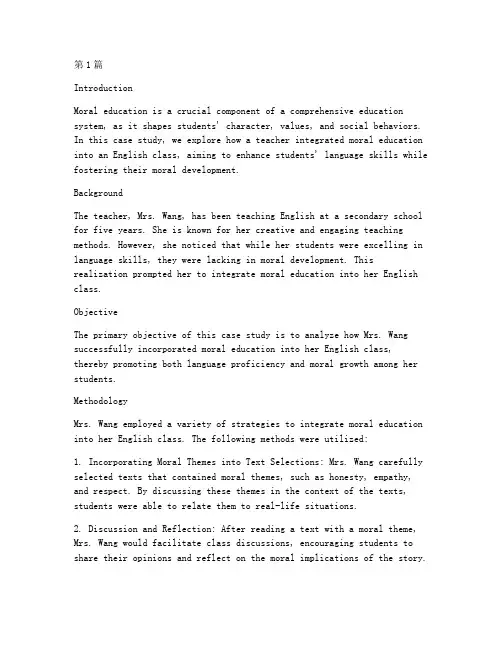
第1篇IntroductionMoral education is a crucial component of a comprehensive education system, as it shapes students' character, values, and social behaviors. In this case study, we explore how a teacher integrated moral education into an English class, aiming to enhance students' language skills while fostering their moral development.BackgroundThe teacher, Mrs. Wang, has been teaching English at a secondary school for five years. She is known for her creative and engaging teaching methods. However, she noticed that while her students were excelling in language skills, they were lacking in moral development. Thisrealization prompted her to integrate moral education into her English class.ObjectiveThe primary objective of this case study is to analyze how Mrs. Wang successfully incorporated moral education into her English class, thereby promoting both language proficiency and moral growth among her students.MethodologyMrs. Wang employed a variety of strategies to integrate moral education into her English class. The following methods were utilized:1. Incorporating Moral Themes into Text Selections: Mrs. Wang carefully selected texts that contained moral themes, such as honesty, empathy, and respect. By discussing these themes in the context of the texts, students were able to relate them to real-life situations.2. Discussion and Reflection: After reading a text with a moral theme, Mrs. Wang would facilitate class discussions, encouraging students to share their opinions and reflect on the moral implications of the story.This not only enhanced their critical thinking skills but also allowed them to develop empathy towards others.3. Role-Playing and Simulations: To further emphasize moral values, Mrs. Wang organized role-playing activities and simulations that required students to make decisions based on ethical considerations. This hands-on approach helped students internalize moral principles.4. Creative Writing Assignments: Mrs. Wang assigned creative writing tasks that required students to write stories or essays with a moral message. This enabled them to express their thoughts and feelings about moral issues while improving their writing skills.5. Homework and Projects: Students were given homework assignments and projects that focused on moral education. For instance, they were asked to research and present on ethical leaders or write essays on how they could contribute to the community.Case StudyOne particular instance that highlights the effectiveness of Mrs. Wang's approach occurred during a unit on environmental issues. The class read a story titled "The Last Tree," which depicted the consequences of deforestation and the importance of environmental conservation.After the reading, Mrs. Wang initiated a discussion on the moral implications of the story. She asked students to share their thoughts on the characters' actions and the consequences they faced. The students were divided into small groups, where they discussed the following questions:- What moral values are emphasized in the story?- How can we apply these values to our own lives?- What steps can we take to protect the environment?The discussions were lively and thought-provoking. Many students expressed a desire to become more environmentally conscious and take action to protect the planet. Mrs. Wang then assigned a creative writingtask, asking students to write a short story or essay that promoted environmental awareness.The results were impressive. Students not only demonstrated their language skills but also showcased their understanding of moral values. Many of their stories and essays highlighted the importance of taking care of the environment, showing empathy towards future generations, and making sustainable choices.ResultsThe integration of moral education into Mrs. Wang's English class yielded positive results. The following outcomes were observed:1. Enhanced Language Skills: Students' language skills, such as reading, writing, speaking, and listening, improved significantly as a result of the various activities and assignments.2. Moral Development: Students demonstrated a greater understanding of moral values and were more likely to apply them in their daily lives.3. Increased Empathy and Social Awareness: The discussions and role-playing activities enabled students to develop empathy towards others and become more socially aware.4. Improved Critical Thinking Skills: The class discussions and reflection activities encouraged students to think critically about moral issues, enhancing their problem-solving abilities.ConclusionThis case study demonstrates the effectiveness of integrating moral education into an English class. By incorporating moral themes into text selection, facilitating discussions, and engaging students in creative writing and role-playing activities, Mrs. Wang was able to foster both language proficiency and moral growth among her students. This approach serves as a valuable model for other educators seeking to enhance the holistic development of their students.第2篇IntroductionMoral education is an essential component of the educational process, aiming to cultivate students' moral values, ethical standards, andsocial responsibilities. The integration of moral education into English classes can be particularly effective, as it allows students to learn about different cultures and values through the medium of a second language. This case study explores a德育教育案例 in an English class, focusing on the theme of respect and inclusivity.BackgroundThe case study takes place in a secondary school in a multicultural city. The English class consists of 30 students, aged 14-15, from various cultural backgrounds. The teacher, Ms. Wang, has been teaching Englishfor five years and is known for her creative and engaging teaching methods.ObjectiveThe objective of this德育教育案例 is to integrate moral education into the English class, specifically focusing on the theme of respect and inclusivity. The aim is to help students understand the importance of respecting others, regardless of their cultural or social differences, and to promote a sense of inclusivity within the classroom and theschool community.Teaching MethodologyMs. Wang decided to incorporate various teaching methods to achieve the德育教育目标. These included:1. Project-Based Learning: The students were divided into groups and assigned a project on a cultural festival celebrated in their home countries. Each group was required to research the festival, create a presentation, and present it to the class. This activity aimed to foster cultural understanding and respect for different traditions.2. Discussions and Debates: Ms. Wang organized class discussions and debates on topics such as discrimination, stereotypes, and theimportance of inclusivity. Students were encouraged to express their opinions, listen to others, and engage in respectful dialogue.3. Role-Playing: Students participated in role-playing activities that simulated real-life scenarios where they had to make decisions based on respect and inclusivity. For example, they were asked to act out situations where someone was being bullied or treated unfairly.4. Reading and Analysis: The class read short stories and poems that highlighted the themes of respect and inclusivity. After reading, students discussed the characters' actions, the consequences of their decisions, and how these scenarios related to their own lives.Case StudyOne particular activity that stood out in the德育教育 process was a debate on the topic of "Is it fair to discriminate against someone based on their race or ethnicity?" The class was divided into two groups: one in favor of discrimination and the other against. Ms. Wang acted as the moderator, ensuring that both sides were given a fair opportunity to present their arguments.The debate was intense and emotional. The "discrimination" group argued that certain races or ethnicities were inherently inferior and that discrimination was necessary to maintain order and societal harmony. The "anti-discrimination" group, on the other hand, emphasized the importance of equality, the negative consequences of discrimination, and the need for inclusivity.As the debate progressed, some students from the "discrimination" group began to reconsider their positions. They realized that their arguments were based on stereotypes and generalizations, and that discrimination was harmful and unjust. By the end of the debate, the majority of the class had shifted their stance against discrimination.Reflection and EvaluationAfter the activity, Ms. Wang conducted a reflection session with the class. Students shared their thoughts and feelings about the debate, andhow it had influenced their views on discrimination and inclusivity. Many expressed a newfound appreciation for diversity and a commitment to promoting inclusivity in their daily lives.To evaluate the effectiveness of the德育教育 activity, Ms. Wang conducted a survey at the end of the term. The survey revealed that the vast majority of students had a better understanding of the importance of respect and inclusivity. Additionally, students reported feeling more comfortable discussing sensitive topics and expressing their opinions in class.ConclusionThis case study demonstrates the effectiveness of integrating moral education into the English class, using the theme of respect and inclusivity. By incorporating various teaching methods and activities, Ms. Wang was able to foster a deeper understanding of these values among her students. The success of this德育教育案例 highlights the importance of promoting moral values through language education and the potential for creating a more inclusive and respectful classroom environment.。
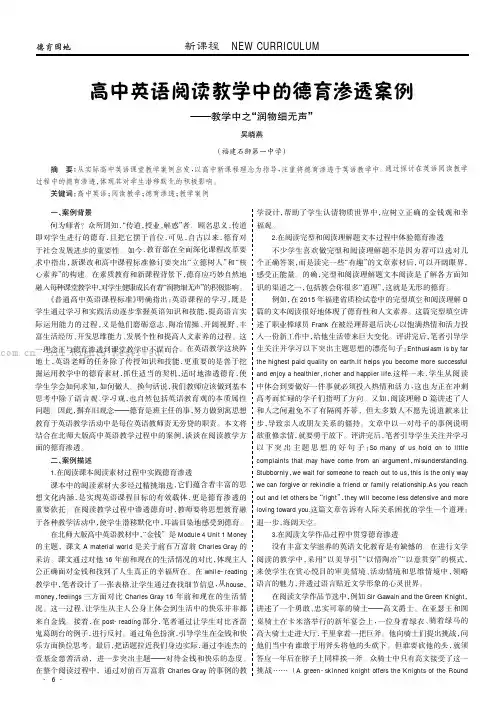
德育园地新课程NEW CURRICULUM一、案例背景何为师者?众所周知,“传道,授业,解惑”者。
顾名思义,传道即对学生进行的德育,且把它摆于首位,可见,自古以来,德育对于社会发展进步的重要性。
如今,教育部在全面深化课程改革要求中指出,新课改和高中课程标准修订要突出“立德树人”和“核心素养”的构建。
在素质教育和新课程背景下,德育应巧妙自然地融入每种课堂教学中,对学生健康成长有着“润物细无声”的积极影响。
《普通高中英语课程标准》明确指出:英语课程的学习,既是学生通过学习和实践活动逐步掌握英语知识和技能,提高语言实际运用能力的过程,又是他们磨砺意志、陶冶情操、开阔视野、丰富生活经历、开发思维能力、发展个性和提高人文素养的过程。
这一理念正与德育渗透到课堂教学中不谋而合。
在英语教学这块阵地上,英语老师的任务除了传授知识和技能,更重要的是善于挖掘运用教学中的德育素材,抓住适当的契机,适时地渗透德育,使学生学会如何求知,如何做人。
换句话说,我们教师应该做到基本思考中除了语言观、学习观,也自然包括英语教育观的本质属性问题。
因此,摒弃旧观念———德育是班主任的事,努力做到寓思想教育于英语教学活动中是每位英语教师责无旁贷的职责。
本文将结合在北师大版高中英语教学过程中的案例,谈谈在阅读教学方面的德育渗透。
二、案例描述1.在阅读课本阅读素材过程中实践德育渗透课本中的阅读素材大多经过精挑细选,它们蕴含着丰富的思想文化内涵,是实现英语课程目标的有效载体,更是德育渗透的重要依托。
在阅读教学过程中渗透德育时,教师要将思想教育融于各种教学活动中,使学生潜移默化中,耳濡目染地感受到德育。
在北师大版高中英语教材中,“金钱”是Module4Unit1Money 的主题,课文A material world是关于前百万富翁Charles Gray的采访。
课文通过对他16年前和现在的生活情况的对比,体现主人公正确面对金钱和找到了人生真正的幸福所在。
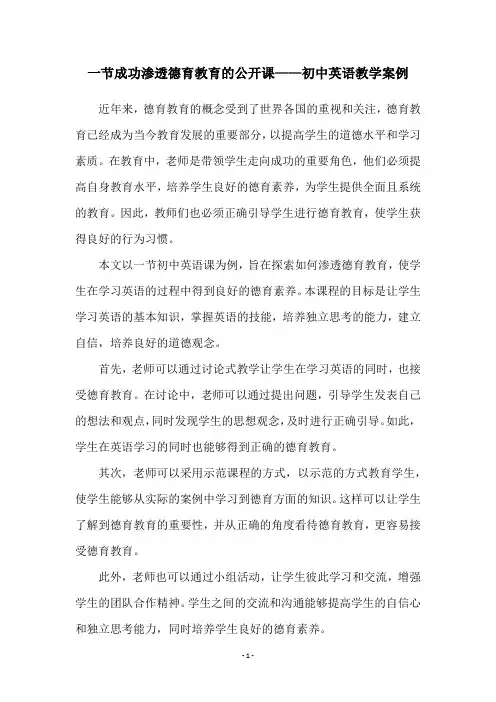
一节成功渗透德育教育的公开课——初中英语教学案例近年来,德育教育的概念受到了世界各国的重视和关注,德育教育已经成为当今教育发展的重要部分,以提高学生的道德水平和学习素质。
在教育中,老师是带领学生走向成功的重要角色,他们必须提高自身教育水平,培养学生良好的德育素养,为学生提供全面且系统的教育。
因此,教师们也必须正确引导学生进行德育教育,使学生获得良好的行为习惯。
本文以一节初中英语课为例,旨在探索如何渗透德育教育,使学生在学习英语的过程中得到良好的德育素养。
本课程的目标是让学生学习英语的基本知识,掌握英语的技能,培养独立思考的能力,建立自信,培养良好的道德观念。
首先,老师可以通过讨论式教学让学生在学习英语的同时,也接受德育教育。
在讨论中,老师可以通过提出问题,引导学生发表自己的想法和观点,同时发现学生的思想观念,及时进行正确引导。
如此,学生在英语学习的同时也能够得到正确的德育教育。
其次,老师可以采用示范课程的方式,以示范的方式教育学生,使学生能够从实际的案例中学习到德育方面的知识。
这样可以让学生了解到德育教育的重要性,并从正确的角度看待德育教育,更容易接受德育教育。
此外,老师也可以通过小组活动,让学生彼此学习和交流,增强学生的团队合作精神。
学生之间的交流和沟通能够提高学生的自信心和独立思考能力,同时培养学生良好的德育素养。
最后,老师可以在课堂上进行反思课程,让学生总结本次课程学习的经验和教训。
这样,学生能够充分理解和学习到德育素养的重要性,有利于他们的健康成长。
总之,通过多种教育方法,可以渗透德育教育,使学生在学习英语的同时,也接受德育教育,提升学生的道德水平和学习素质。
只有以良好的道德观念和素养来教育学生,学生才能得到全面的综合能力和道德素质的提高,并在未来发展中受益。

英语学科德育渗透案例白泡子中学高珍凤教书育人,德育为先。
《教学大纲》中明确指出:“各学科教学是向学生进行思想品德教育最经常、最基本的途径,它对培养学生的思想品质具有最重要作用。
”英语是一门语言,它不仅是用来表达意思,也是用来表达思想感情的工具,文道统一,以文载道。
在英语教学中要充分选择英语教学和思想教育的结合点,进行有意教育,努力培养学生的优良品德,树立积极向上的人生观和世界观。
初中英语教材中的许多文章都遵循着学科中渗透德育的原则。
我们在教英语知识的同时,要选好切分点,抓住契机,对学生进行有意识的品德教育。
一、挖掘文章的德育主题教学案例片段(一)思考的问题:我们为什么学习英语?案例片段描述:我在教学Junior English For China Book 3 Lesson 34时设计以下片段。
Teacher: Why do we learn English?Student A: Because it’s important.Student B: Because it’s useful.Student C: I don’t know. I don’t like English.听完这位同学的回答,我观察同学们脸上的表情,似乎很有同感。
看来同学们不明白为什么要学习英语。
我接着问: How is English important?Student D: I can go abroad if I learn English.Student E:I can sing English songs if I learn English. Teacher: Very good. You are right. If we learn English, we can learn much knowledge from Western countries. We can learn to use computers and improve computers.我告诉他们学习英语不是崇洋媚外,是洋为中用。
英语教学中的德育渗透案例
—
英语课堂中的话题讨论与德育的有机融合
教师作为人类灵魂的工程师,不仅要教好书,还要育好人,各个方
面都要为人师表。教书,不是简单地说教,而是一种精神的体现,是一
种深厚的知识内涵和文化品位的体现!学生需要培养,需要教育。成功
的教育虽然是多元的,但其前提是受教育者正确道德观的形成。而不同
时代有不同的道德观,不同职业有不同的道德内涵,但无论哪个时代,
也无论何种职业,道德观念必有其共通的地方。作为一名英语教师,不
仅要不断地进行改革和创新,提高学生的语言表达能力,还要不断地提
升自身的师德修养,为学生创设语言交流环境,使之说得出、听得懂,
指导学生在获取并掌握语言文化知识及丰富语言材料的同时,围绕主题
进行语言综合应用能力的训练。不仅要努力提高学生的听说能力,而且
还要结合教材挖掘深层含义。与此同时,将教材内容的含义外延与学生
的现实生活打通。这样,教师便能更有效地将德育内涵融于教学当中。
这样才能做到与时俱进,适应新时期发展的需要,完成教书育人的工作
重任。有了师德修养,自然教学水平就会得到很大的提高,这是相辅相
成的。
如何在英语课堂中把提高学生的听说能力与教材中的德育内涵有
机融合?
这是一个范围很大的命题,然而语言是思想、观念及文化的载体,
对学习者不可避免地起着潜移默化的作用。以下是我觉得自己在英语课
堂中的话题讨论这一教学环节中渗透德育的一个案例:
1、思考问题:如何在英语教学中渗透德育教育, 体现英语学科的育人
价值?
2、案例片段描述:我在讲解unit5 If you go to the party,you will
have a great time .的基本句型 “If… ,… will…”后,设计了这
样一个片段:
T:If you grow up, what will you do?(如果你长大了,你将会做些
什么?)大部分学生谈到长大时,他们说会买房,买车,周游世界……,
他们在谈及这些理想时很少表达对父母和家人的感激之情。那他们会不
会表达自己对家人的感激呢?所以我又顺势问学生:
T:Do you know how old your parents will be when you grow up?
(你们知道当你们长大的时候,你们的父母都多大年纪了吗?) What do
you usually do for your parents? (你们平日里为父母做些什么?)
Have you ever given your parents a present? (你们曾经送过礼物
给父母吗?)
学生沉默片刻,我转移话题What will you do for your parents if
you grow up?(如果你们长大了,你们将会为父母做些什么呢?) 沉
闷的气氛一下子打破了。学生们踊跃发表自己的见解:“I will give them
some flowers(我将送给他们一些鲜花);I will make my parents happy
every day(我将使我的父母快乐每一天);I will buy a big house for
them, I will take care of them …(我将给他们买幢大房子,我将
照顾他们……)”
3、教学反思:如今的孩子都觉得自己目前所享受的一切幸福都是父母
应该给予的,关于对父母的感恩,大多数学生都很少去思考。之前也很
少有学生在父母面前表达子女的孝心。设计话题“What will you do for
your parents if you grow up?(如果你们长大了,你们能为父母做些
什么?)”, 通过有效的方法,教育学生关心并感恩长辈,引导学生
学会关心他人,营造一种爱的氛围。在英语教学中渗透德育教育,体现
英语学科的育人价值。
在课堂教学中力求创造气氛陶冶学生,让教材中所展示出来的鲜
明、真实、感人的形象打开他们心灵的大门。引导学生用正确的思维方
式进行有效的学习,设计一些与课堂讨论有关的问题,以便使学生在学
习知识的同时,能对生活有所感悟,能换位思考,同情理解他人,提升
自身道德修养。例如,我在讲Unit2 What should I do?,讲到句型“…
should do…”时,通过结合当前社会生活中所遇到的问题如“Many people
in the earthquake don’t have enough houses to live in(震区的许多人没有
足够的房子住);there is too much pollution around us(我们周围的环境
污染很严重);there is an old man on the road who lost his way(路上的
一位老人迷路了);many kids in the poor countries can’t get an education
(许多贫穷地方的孩子上不起学)……”,布置学生用英语给他人提出
意见或想办法帮助他人度过难关,用文字记录下来,这样不仅培养了学
生的发散性思维,达到学以致用,又增强了学生的同情心,让他们学会
关心帮助遇到困难的人,关注环境问题增强环保意识等等。我还注意学
生在发言中的语言知识的运用是否准确,以话题讨论的方式一方面激发
学生作更深层次更有创意的思考,另一方面可以无形的提高学生的道德
水平,使学生逐步增加自信,理解别人的观点和看法,进而正确表达自
己的观点和思想。
在课堂活动中,我认为教师所要把握的是,不要因为只强调培养学
生的语言能力而机械地去训练,以至于肢解了教材内容,也不要因侧重
道德教育而虚化了语言的学习。我们应该为语言训练与道德教育找到最
佳平衡点,真正做到语言知识的学习、语言技能的训练与道德教育的有
机融合。
总之,做为一名英语教师,我要在钻研专业知识的同时,努力掌握
和提高德育知识,把德育渗透贯穿到英语教学的始终,因为中学英语教
学的德育渗透是个“度”的把握问题,不可能一蹴而成,更是一个漫长
的过程,所以在以后的工作中我要持之以恒,常抓不懈,不断反思,不
断改进,争取在英语教学与德育渗透方面取得更大的进步。
陕西省基础教育教学成果参评
英语教学中的德育渗透案例
—英语课堂中的话题讨论与德育的有机融合